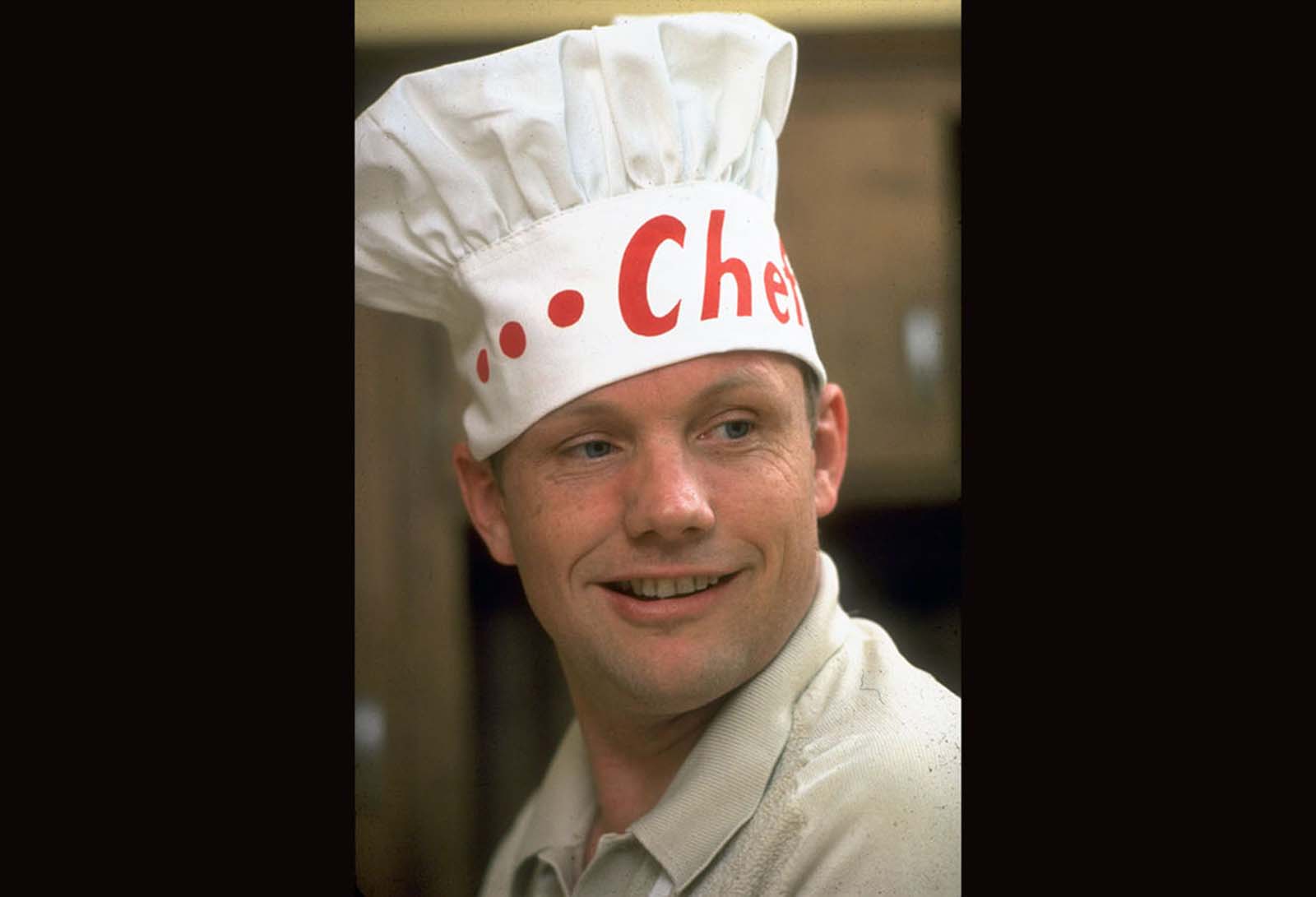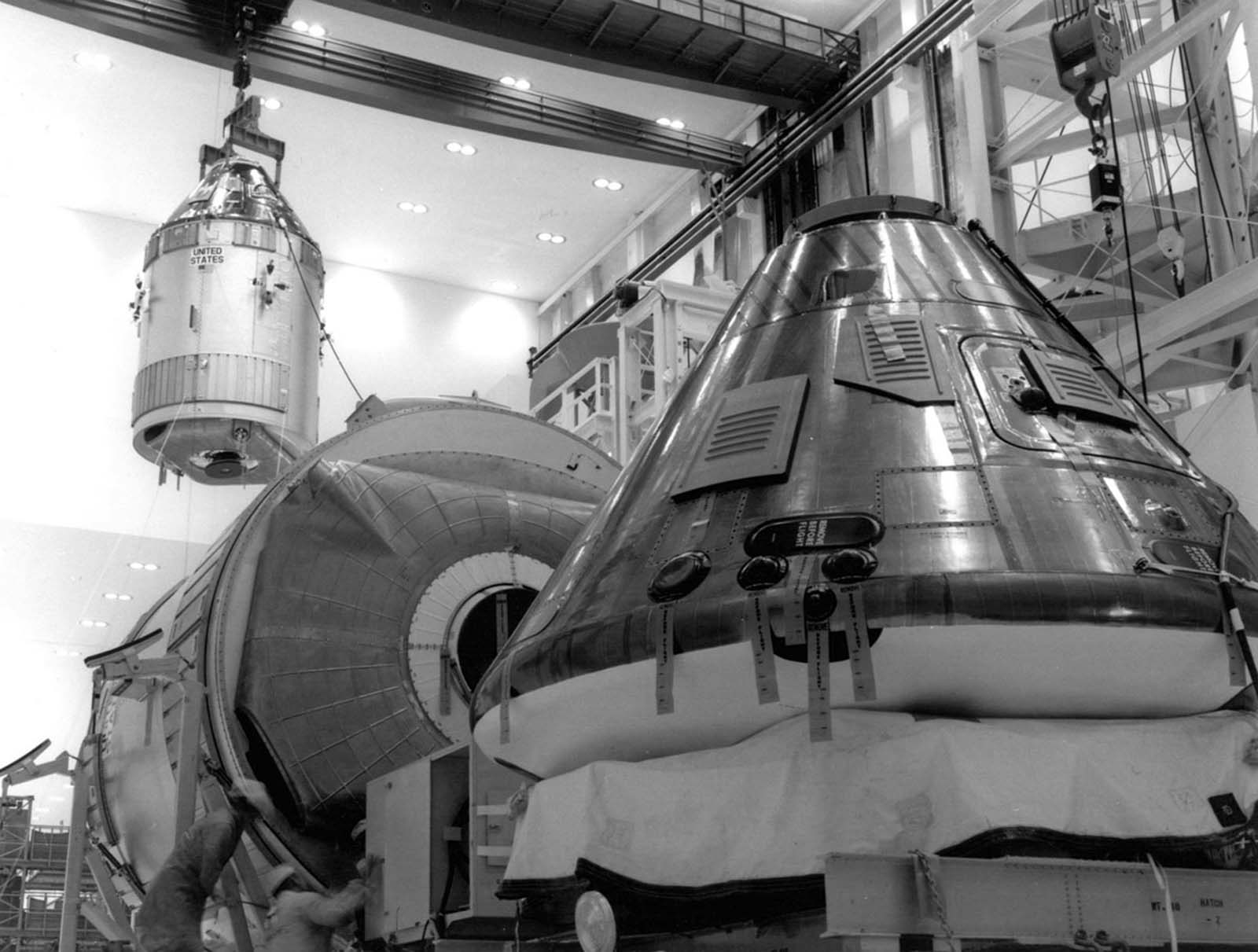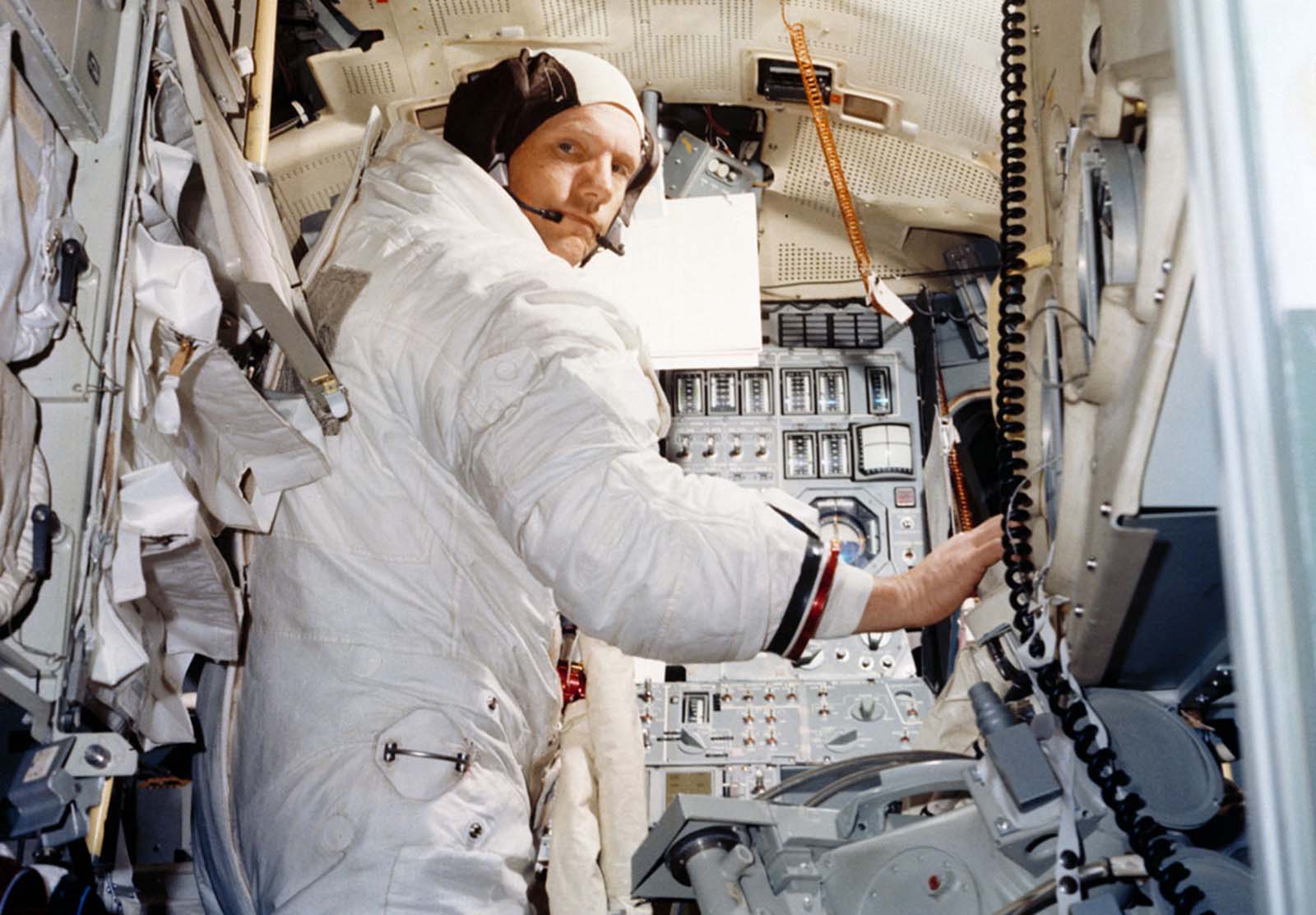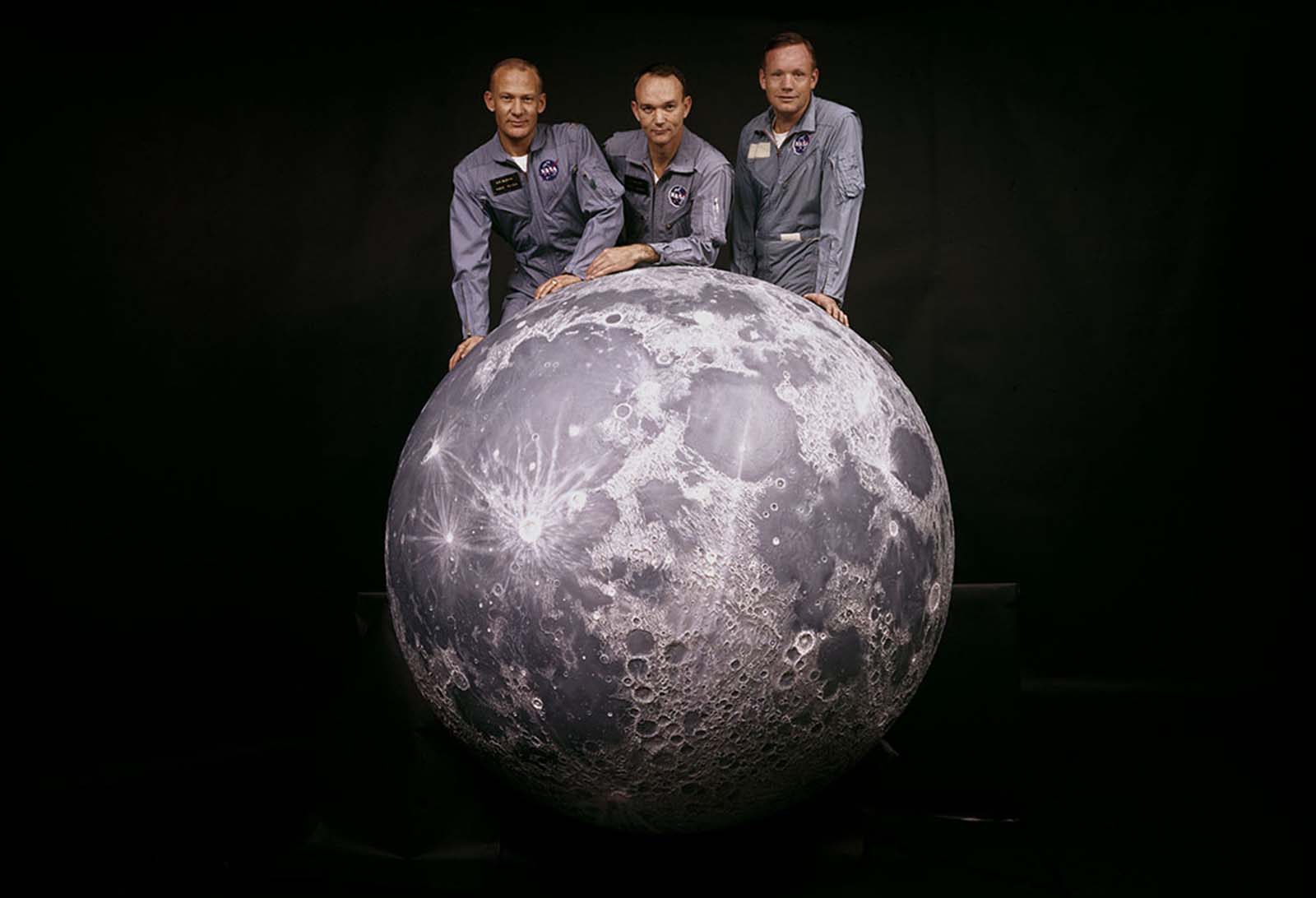
The Bell Aerosystems Lunar Landing Research Vehicle (LLRV) and the astronaut Neil Armstrong (left), photographed at Edwards Air Force Base in Southern California prior to the launch of Apollo 11.
Apollo 11 was the climax of the Apollo program, which pushed human spaceflight forward faster than ever before.
In October 1968, the first crewed flight of the Apollo program lifted off; less than a year later, Apollo 11 launched.
Within just a few short years, a total of six missions landed 12 American astronauts on the surface of the moon.
“We choose to go to the moon,” U.S. President John. F. Kennedy famously declared in 1962 to a captivated crowd at Rice Stadium in Texas.

A group portrait of NASA’s Apollo 11 astronauts posing with their families around a model of the moon in March 1969. Pictured are: (at top, from left) the astronaut Michael Collins; his children, Mike, Kate, and Ann; and his wife, Pat; (at left) the astronaut Buzz Aldrin; his wife, Joan; and his children, Mike, Jan, and Andy; and (at right) the astronaut Neil Armstrong; his wife, Jan; and his sons, Ricky and Mark.
This speech invoked a new urgency in the space race, which had been going on between the U.S. and the Soviet Union.
The two Cold War rivals were both determined to outdo the other and land humans on the lunar surface first.
The U.S. efforts in this contest included two predecessors to Project Apollo: Project Mercury, which began in 1958, and Project Gemini, which followed in 1961.

An Apollo astronaut operates a flight simulator during mission training for NASA’s space program in Dallas, Texas.
But until the moon landing itself, the Soviet space program was ahead overall, with successful missions including Sputnik, the first satellite to orbit Earth, and Luna 2, the first space probe to touch the moon.
The ambitious goal required an equally ambitious budget. T
he U.S. government ended up allocating $25 billion in 1960s dollars to the Apollo program, or about 2.5% of the U.S. gross domestic product (GDP) at the time annually for approximately 10 years.

The S-1C booster for the Apollo 11 Saturn V waits inside the Vehicle Assembly Building at NASA’s Kennedy Space Center in Florida on February 21, 1969.
The systems, materials, and techniques necessary to achieve this goal were nearly all brand new and required extensive testing and research before they were sent 240,000 miles away from home. The astronauts were new to this as well, pioneers headed to a new world—literally.
The world was fascinated with NASA’s progress as it approached the launch of Apollo 11 in July 1969, when the astronauts Michael Collins, Buzz Aldrin, and Neil Armstrong left Earth to touch down on the moon.
Collected here, some of the training, preparation, and daily life that occupied the astronauts and their NASA support team in the months leading up to Apollo 11.

An official portrait of Apollo 11 Lunar Module Pilot Buzz Aldrin.

Original caption: Practicing for the Big One at Ellington A.F.B., Texas. Apollo 11 Commander Neil Armstrong flies the Lunar Landing Training Vehicle in preparation for the lunar-landing attempt in July. The flight lasted for five minutes, during which Armstrong made two takeoffs and landings. He flew the craft to an altitude of some 300 feet.

The astronaut Buzz Aldrin paddles to the shore of Lake Texoma during training at the U.S. Air Force Air Defense Command Life Support School at Perrin Air Force Base in Sherman, Texas. He sits in a one-man life raft. He was dropped into the water after making a parasail ascent some 400 feet above the lake.

The astronauts Neil Armstrong and Buzz Aldrin take part in a geology field trip in Sierra Blanca, Texas.

From a Life magazine series on the Apollo astronauts at home, a photo of Michael and Pat Collins and their children enjoying a relaxing pancake breakfast in March 1969.

Apollo 11 Command Module Pilot Michael Collins enjoys some time with his dog.

From left: The astronauts Neil Armstrong, Michael Collins, and Buzz Aldrin talk over drinks in a wood-paneled room in Houston, Texas, in March 1969.

Buzz Aldrin and his sons practice pole vaulting at his Texas home.

Buzz and Joan Aldrin share a kiss in the kitchen of their Texas home.

Neil Armstrong and his sons, Ricky and Mark, scuba dive in a swimming pool in Houston, Texas, in March 1969.

Chef Neil Armstrong, at home in March 1969.

Apollo 11 Commander Neil Armstrong trains in the spacesuit he will wear on the lunar surface. A camera is attached to his chest, giving him full use of his arms; the backpack provides oxygen, pressurization, and temperature control.

The command module and service module for the Apollo 11 mission are moved to the work stand on April 1, 1969, in preparation for the first manned lunar landing.

The final checkout of the Apollo 11 lunar module takes place on April 11, 1969, in the Open Bay Area of the Manned Spacecraft Operations Building at Kennedy Space Center.

A preflight photo shows Buzz Aldrin’s suit laid out in its lunar-surface configuration.

A fish-eye view of the astronauts Buzz Aldrin and Neil Armstrong as they train in a mock-up lunar module.

Buzz Aldrin (left) and Neil Armstrong train to make documented sample retrievals, suited up near a mock-up of the lunar lander in the spring of 1969.

Neil Armstrong (left) and Buzz Aldrin brief NASA managers before a training session described in the crew-training summary as a “Lunar Timeline Demo for Dr. Mueller” on April 22, 1969.

Command Module Pilot Michael Collins works inside a simulator.

The astronaut Buzz Aldrin, fully suited, gets in more training time under partially weightless conditions aboard a KC-135 aircraft from the Wright-Patterson Air Force Base on July 9, 1969. The moon’s gravity is about one-sixth that of Earth.

Neil Armstrong trains in a lunar-module simulator in June 1969.

The command and service modules for Apollo 11 are installed in the altitude chamber of the Manned Spacecraft Operations Building at Kennedy Space Center.

The Apollo 11 crew walks past the base of the massive Saturn V first stage during a walk-through emergency-egress test.

Apollo 11 crew members pose for a photo during a walk-through egress test on June 10, 1969.

Readying for launch, a technician works atop the white room, through which the astronauts will enter the spacecraft, alongside the 363-foot (111-meter) Saturn V rocket standing on the launchpad at Kennedy Space Center.

A portrait of Buzz Aldrin, Michael Collins, and Neil Armstrong, the crew of NASA’s Apollo 11 mission to the moon, in the spring of 1969.
(Photo credit: The Life Picture Collection).
Updated on: August 3, 2024



